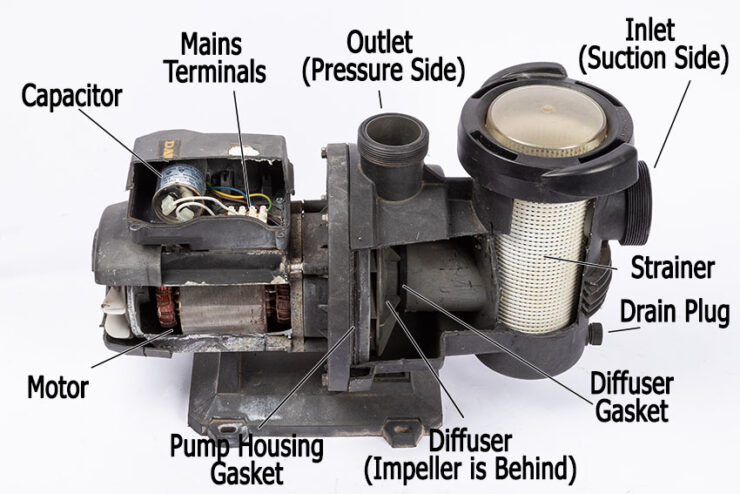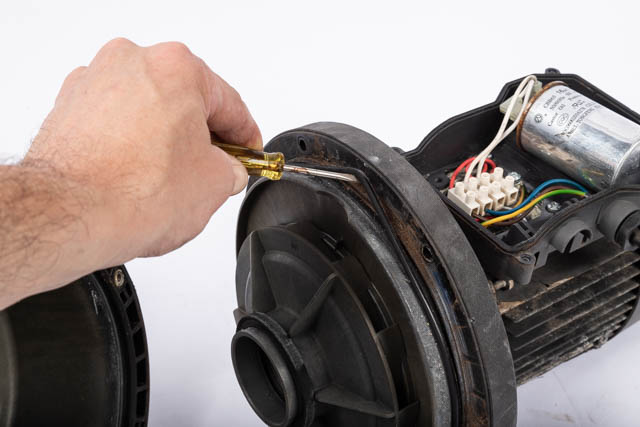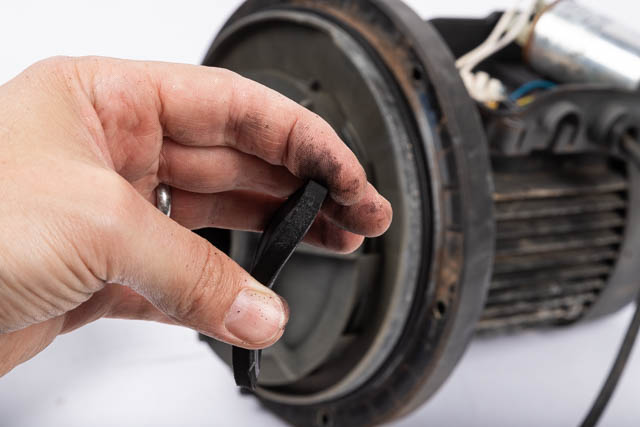Pool pumps leaking from the band clamp is a common problem. This problem can start out as a drip or small trickle and turn into a spraying leak if it isn’t fixed. It may be that your pump just started doing it. Or perhaps you’ve just reassembled your pump after another repair and it has started leaking.
No to worry, it’s an easy fix. In this article, I’ll list out some of the common causes and ways to stop your pump from leaking from the band clamp.
What Does the Band Clamp Do?
Before we get into it, here’s a quick recap on what the band clamp does. Pool pumps are essentially made in two halves. One half has the motor. The other is the wet side of the pump, called the pump housing. The pump housing contains the diffuser, impeller (attached to the motor), and strainer.

Some pumps use bolts or screws to join the two halves of the pump together whilst others use a band clamp. Whichever way the pump is joined, there will be an o-ring seal or gasket sealing them.
This seal stops the water from inside the pump housing from dripping and leaking out.
Reasons Why Pool Pumps Leak from the Band Clamp
1) The Pump Housing Gasket / O-Ring Needs Replacing
This is the most common reason pool pumps leak from around the band clamp. As explained earlier, it’s this o-ring that seals the two halves of the pump and prevents water from leaking out.
The leak can come from the sides of the pump of water leaks from the bottom of the pump.
Solution: Check and replace the pool pump housing gasket o-ring. First try lubricating the seal then reassembling. It may be the seal wasn’t seated correctly.
Saying that, even if the o-ring is fairly new, I have heard that some pool pumps leak after being opened unless the seal is replaced.

Here’s how:
1) Switch off your pool pump at the circuit breaker.
2) Open the filter pressure relief valve to release the pressure.
3) Remove the band clamp from your pool pump and separate the pump housing from the motor. You may need to remove the unions of the inlet and outlet pipes connecting to the pump.
Sometimes you’ll also need to tap the housing with a mallet to separate the two parts.
4.) Inspect the condition of the pump housing o-ring seal. Here are the signs of a bad o-ring gasket seal:
- The seal has cracks in it.
- It’s brittle and not flexible.
- The shape is stretched and misshapen.
- Your fingers are covered in black after touching them.

5.) Replace the o-ring seal with a new one. Keep the following in mind:
- Be careful to order the correct seal.
- Clean out the groove where the o-ring sits. If there are any parts of old seal or dirt, you need to get this all out.
- Clean the two surfaces that mate together around the seal i.e. pump housing and motor seal plate.
- Use o-ring lubricant on the seal to improve the seal.
6.) Reinstall the band clamp and tighten it up.
Pro Tip: be careful that the seal stays in the correct place when joining the two halves of the pump together. It needs to stay in the groove. If the o-ring moves, the pump will likely leak.
Related Reading: Pool Pump Impeller Stuck on The Shaft: How to Remove
2. Dirt and Debris on Seal Surfaces
If your o-ring seal is new and your pump still leaks, another possibility is that the seal surfaces have debris on them. Old gaskets and o-rings can leave behind the rubber. Also, dirt can get in and around the seal surfaces.
Solution: As above, open up the pool pump again, remove the O-ring seal and thoroughly clean the groove or channel that the o-ring sits in. Any dirt, debris, or rubber from the seal needs to be removed. Also, clean the flat surfaces around the seal. Do this for both sides of the pump
You can use a screwdriver or metal scraper to help with this. The surfaces should feel smooth when done.
Now reinstall the o-ring, use some seal lube, and be careful that the seal stays in place when joining the pump housing and motor back together.
3. Incorrect O-Ring / Seal Used
For the pump housing gasket to work correctly and not leak, it’s essential it is the correct part. Seals are usually made to very tight tolerances and can leak if they aren’t exactly the right fit.
Even if they visually look the same, if they’re the tiniest bit different, it can be enough for the pump to leak.
Solution: Double-check the pump part number and check that you have ordered the correct o-ring. Check you were sent the correct part too – sometimes stores make mistakes.
A Note on the Pentair Challenger Pump
There have been several cases of Pentair Challenger pumps leaking from the band clamp. The solution is to replace the O-ring. However, some pool stores and cheap generic seal kits supply the wrong o-ring.
The profile of the correct o-ring for this pump is square-shaped. It’s NOT a round o-ring. The part number for the right o-ring is #355329.
Related Reading: 12 Reasons Pool Pumps Leak (and How to Fix)
4. Band Clamp is Loose or Not Located Correctly
If you’re lucky, it may be a simple case that you haven’t tightened up the band clamp enough. Or it isn’t seated correctly.
Solution: Loosen the band clamp and take it off again. Make sure the motor and the pump housing are sitting together tightly and the o-ring is seated correctly (in the groove). Now loop the band clamp around the housing and motor.
Both the housing and motor seal plate edges should be inside the band clamp. Then you want to slowly tighten the clamp up, ensuring that it is sitting in the correct place when doing so. The knob or bolt of the band clamp usually goes up the top.
Keep tightening it so it’s quite tight. You don’t want to over-tighten it though.
5. Lubricate the O-Ring Seal
Using o-ring lubricant on the seals inside your pool pump helps to protect them and make them last longer. Additionally, seal lubricant will help form a better seal and stop leaks.
When using a seal lube for your pump, use a Teflon or PTFE-based sealant. This is safe for rubber seals. Don’t use a petroleum-based lubricant, as that will eat natural rubber O-rings.
Solution: Take apart the pump again, remove the pump housing o-ring seal and apply plenty of o-ring lubricant to it. Reassemble the pump.
6. The Leak is Coming from Somewhere Else
It’s also possible that the leak isn’t coming out of the band clamp.
Here are some places to check:
- Pump Lid – this is one of the most common places pumps leak from. Check the lid for cracks, and it is tightened up correctly.
- Top of the pump – check the water isn’t leaking down from the unions.
- Motor Shaft Seal – this leak will be at the bottom of the pump and usually on the motor side near the band clamp.
We have a full article detailing this: How Do You Know If Pool Pump Shaft Seal Is Bad? - Cracked Pump Housing – although not common, it is possible that the housing of the pool pump has a small crack in it. Make sure the outside of the pump is dry and with the pump on, inspect the pump carefully for a water leak.


